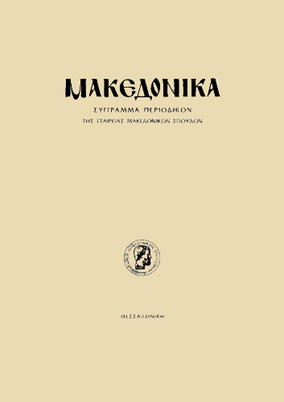Γύψινες ανάγλυφες διακοσμήσεις της μεσοβυζαντινής εποχής στο καθολικό της μονής Ιβήρων
Part of : Μακεδονικά ; Vol.36, 2007, pages 47-64
Issue:
Pages:
47-64
Parallel Title:
Middle-Byzantine plaster reliefs in the katholikon oflviron monastery
Section Title:
Articles
Abstract:
In addition to the marble sculptures, the katholikon of Iviron Monasteryincludes some most remarkable plaster relief ornamentation from the middleByzantine period. One such plaster relief, framing the arch-shaped opening ofthe funerary arcosolium at the north end of the inner narthex, has beenexamined in the context of the study of the monastery founders’ tombs[Th. N. Pazaras, «Founders’ tombs in the katholikon of Iviron Monastery»,Byzantina 26 (2006) 125-151 (to be published shortly)]. The main subject of this study is another such piece of plasterornamentation, in the form of a triple arch, which can be found above thelintel of the Imperial Door, that is the central door leading from the narthexinto the naos. This plaster archwork is composed of a central elevated arch,supported by two colonettes and framed on both sides by two lower quartercircle arches. The roots of such a conception of a triple, symmetrical archwork are perhaps to be sought in Middle Byzantine Constantinopolitan architecture, even though similar ornamental compositions can also be found inivory work and in illuminated manuscripts from the same period.All arches are adorned with various scrolls and are framed on the outsideby tightly braided guilloches, with either a fine dentil course or a series ofstylized bead-and-reel along the inner edge. The colonettes of the middle archare likewise covered from base to capital with relief ornamentation. All those themes are in very wide use in Middle Byzantine decorative art,whether in monumental painting and illuminated manuscripts or in miniatureart and above all in sculpture. This leads us to date the plaster archwork tothe 10th-11th century. Using what is known about the foundation of theMonastery and the building history of the katholikon, in conjunction with thetestimony of archival sources, one can even attempt a more precise dating,from the end 10th to mid-11th century. This estimate can be narrowed downeven further, to some time between 1029 and 1066, for the archwork underconsideration appears to be closely related to the plaster relief archwork ofthe above mentioned northern grave of the inner narthex of the samekatholikon, which was built between those same years.
Subject:
Notes:
856:https://ejournals.epublishing.ekt.gr/index.php/makedonika/article/view/5587, DOI: http://dx.doi.org/10.12681/makedonika.24
Electronic Resources:




